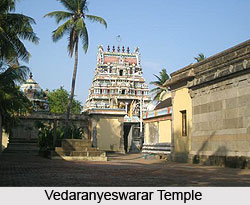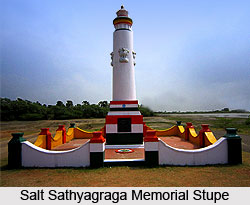 Tourism of Vedaranyam covers the ancient Hindu temples which are dedicated to Lord Shiva. The temples of Vedaranyam are Vedaranyeswarar temple, Dharbaranyeswarar Temple, Kayarohanaswamy Temple, Kannayariamudayar Temple, Brahmapureeswarar Temple, Vaimoornaathar Temple and Tiruvarur Thyagaraja Temple.
Tourism of Vedaranyam covers the ancient Hindu temples which are dedicated to Lord Shiva. The temples of Vedaranyam are Vedaranyeswarar temple, Dharbaranyeswarar Temple, Kayarohanaswamy Temple, Kannayariamudayar Temple, Brahmapureeswarar Temple, Vaimoornaathar Temple and Tiruvarur Thyagaraja Temple.
Vedaranyeswarar Temple
Vedaranyeswarar temple is an ancient Hindu temple dedicated to Lord Shiva or Mahadeva. Vedaranyeswarar temple is located in Vedaranyam, a town of religious importance. Vedaranyeswarar temple has a shrine for Thyagaraja, a divine form of Lord Shiva, known for "Hamsapthanathaanam". "Hamsapthanathaanam" is the dance pose similar to the gait of a swan. According to the medieval history of Chola Empire, a Chola king named Mucukunta obtained a boon from Indra to receive an image of Thyagaraja from the Hindu god Lord Vishnu. Indra tricked the king with six other duplicate images, but the king chose the right image which was later installed at Thyagaraja Temple of Tiruvarur.
Thyagaragar Temple
Thyagaragar Temple is an ancient Hindu temple dedicated to Lord Shiva. Thyagaragar Temple is located in the town of Thiruvarur in Tamil Nadu. Lord Shiva is worshiped as Moolanathar. The consort of Mahadeva, Parvati is depicted as Kamalambigai. The presiding deity of Thyagaragar Temple is revered in 7th century Tamil Shaiva Canonical work, the "Tevaram", written by Tamil saint poets known as the Nayanars and classified as Paadal Petra Sthalam.
Tirunallar Saniswaran Temple
Tirunallar Saniswaran Temple, also called as Dharbaranyeswarar Temple is a Hindu temple dedicated to Lord Shani. Tirunallar Saniswaran Temple is located in Tirunallar in Karaikal district of Puducherry. The presiding deity is Lord Shiva. Tirunallar Saniswaran Temple is revered by the hymns of 7th century Tamil Shaivite poets, Appar, Cuntarar and Campantar.
Kayarohanaswami Temple
Kayarohanaswami Temple is an ancient Hindu temple dedicated to Lord Shiva or Mahadeva. Kayarohanaswami Temple is situated in the town of Nagapattinam in Tamil Nadu. The presiding deity is known as Kayarohana and his consort is Nilayathakshi. The temple has been in existence from the 6th century AD and has been praised by the Nayanmars Appar, Sambandar and Sundarar. Kayarohanaswami Temple has been constructed by the Lakolisa cult which originated in Gujarat.
Salt Sathyagraga Memorial Stupe
Salt Sathyagraga Memorial Stupe built in memory of the historical Salt March during India`s independence movement, organised by C. Rajagopalachari is another prominent modern monument in Vedaranyam.
Other tourist destinations around Vedaranyam are Ayurvedic Medicinal Forest, Point Calimere Wildlife and Bird Sanctuary which is located Point Calimere at a distance of 10 kilometers. There are other tourist destinations like Historical Light House, Ramar Paatham, Ettukudi Murugan temple, which is located at a distance of 40 kilometres and Our Lady of Good Health in Velankanni located at a distance of 37 kilometres from the town of Vedaranyam.



















